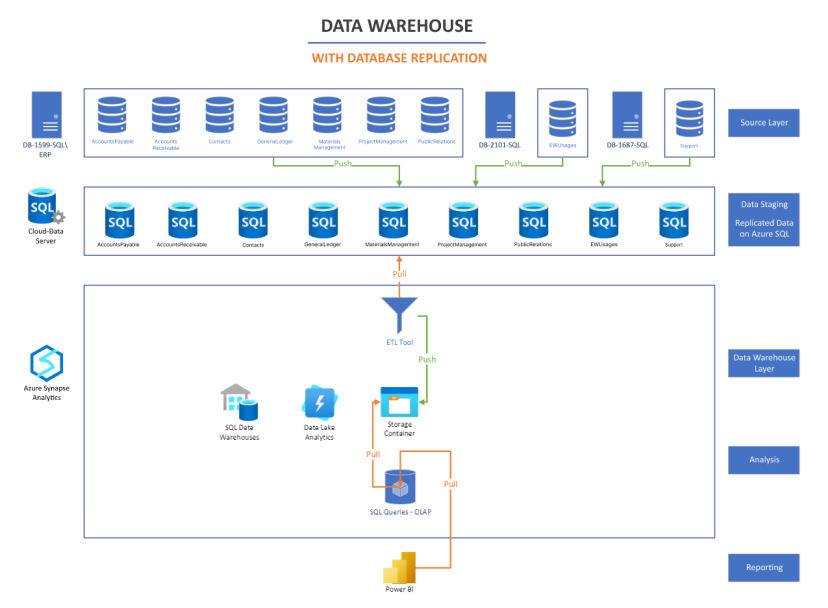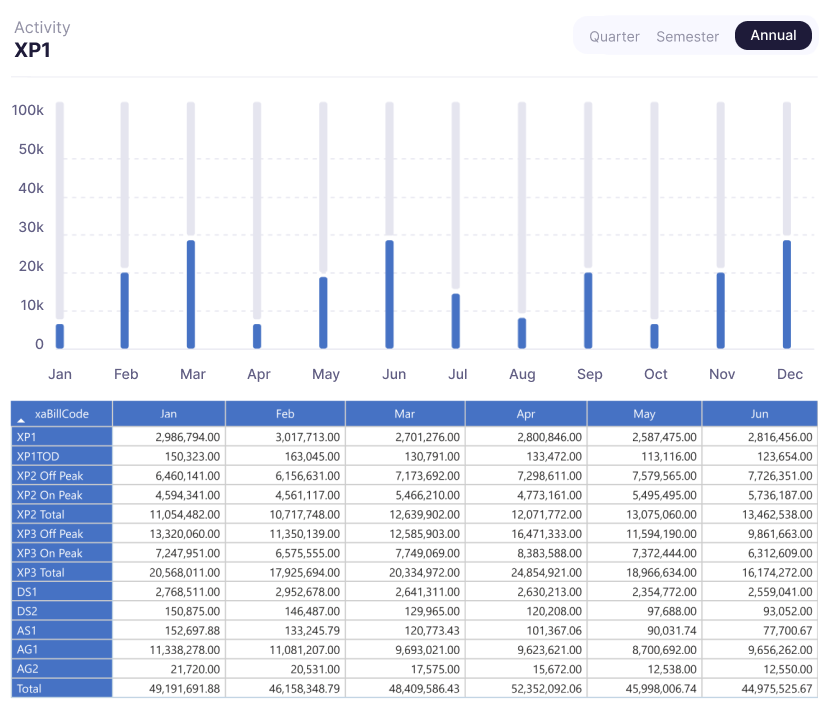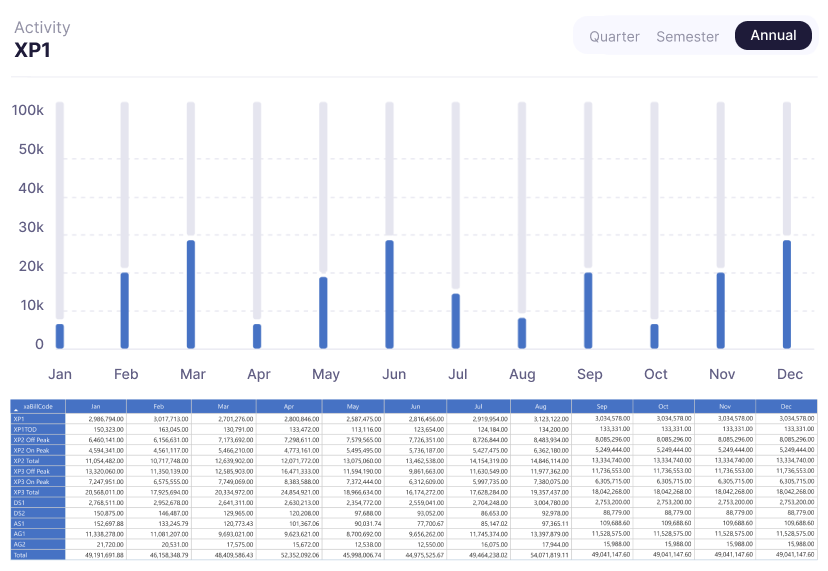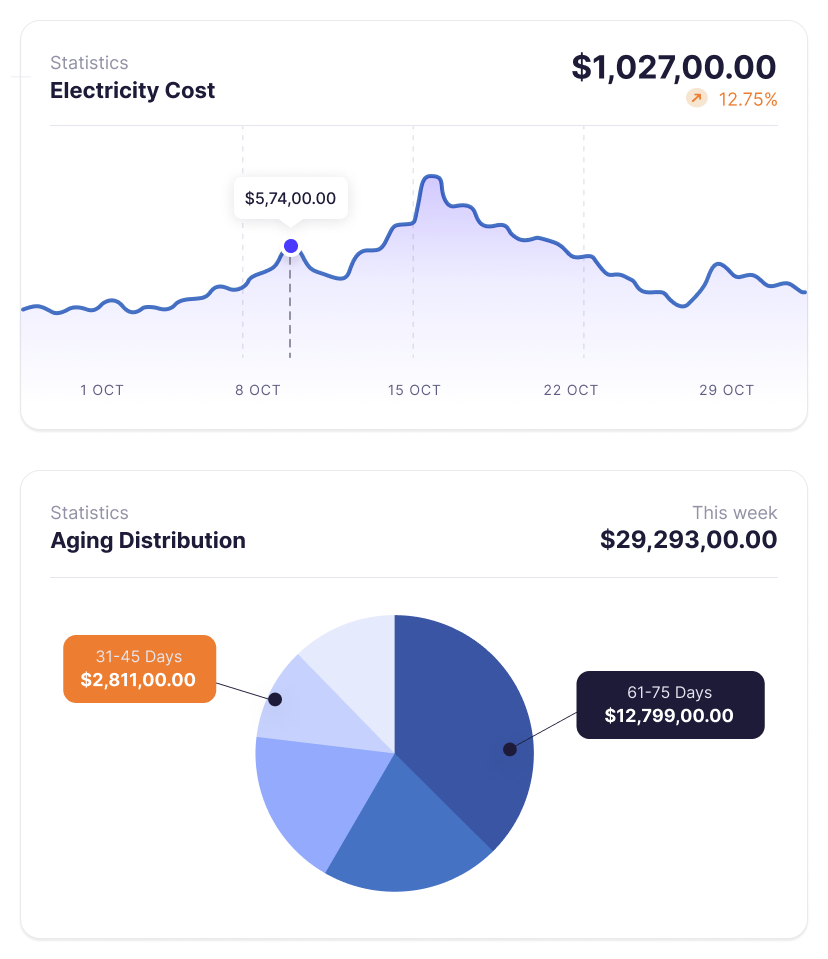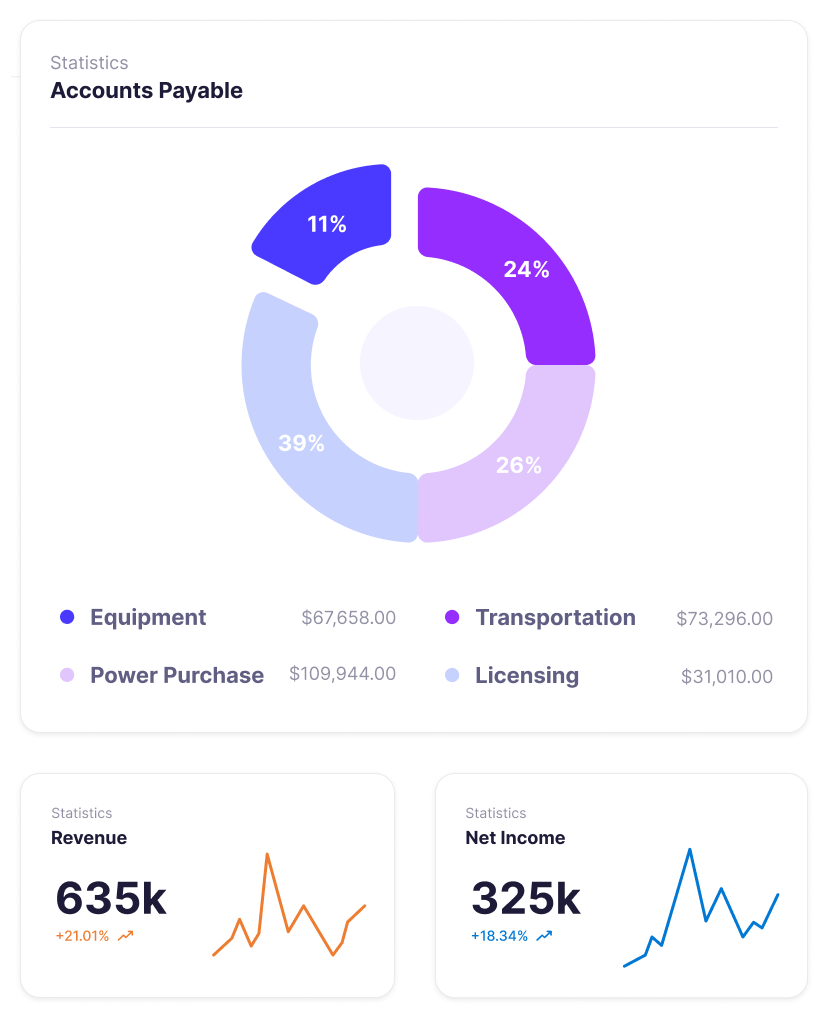
About client:
The client is an electric and water utility company in Kaukauna, Wisconsin, USA.
The primary vision of the company was to find opportunities using data warehousing.
- Decrease water losses by 17%
- Decrease electric losses by 2.9%
- Generation – Maintain 98%+ runtime/uptime availability.
- Maintain 25 minutes or better SAIDI reliability.
- Improved perception of water in the community by delivering better reporting
Need:
The need was to build a data warehouse on top of their distributed systems and databases to create on-demand reports with the help of the business intelligent tools.
We evaluated all the following popular platforms for Data warehousing:
- Amazon Redshift: Part of AWS, it’s a fully managed, petabyte-scale data warehouse service. Redshift is designed for high performance using columnar storage and data compression, and it integrates well with other AWS services.
- Google BigQuery: A serverless, highly scalable, and cost-effective multi-cloud data warehouse designed for business agility. BigQuery is known for its speed and ease of use.
- Snowflake: A cloud-based data platform offering a wide range of capabilities including data warehousing, data lakes, data engineering, data science, data application development, and sharing. Its architecture allows for automatic scaling, performance, and concurrency.
- Microsoft Azure Synapse Analytics (formerly SQL Data Warehouse): Integrates big data and data warehousing, providing a unified analytics platform to analyze all data with deep integration with other Azure services.
- Oracle Cloud Infrastructure Data Warehouse (OCI Data Warehouse): A fully managed, high-performance, and elastic database service. It offers autonomous operations, reducing management overhead.
We narrowed it down to Microsoft Synapse as the company is already invested and aligned with Microsoft’s ecosystem. Below are a few compelling reasons to choose Azure Synapse Analytics:
- Seamless Integration with Azure Ecosystem: Azure Synapse offers deep integration with other Azure services, including Azure Data Lake Storage, Azure Machine Learning, Power BI, and Azure Data Factory, allowing for a more cohesive and streamlined data and analytics solution.
- Unified Analytics Platform: Azure Synapse provides a single service for all your analytics needs, from data ingestion to big data analytics, data warehousing, and machine learning. This eliminates the need for multiple solutions and simplifies the architecture.
- Serverless On-demand Query Processing: Azure Synapse offers serverless on-demand query processing, which allows you to run big data analytics without managing infrastructure, paying only for the queries you run, which can lead to significant cost savings.
- SQL and Spark Pools: It supports both SQL and Spark pools, enabling you to query data using either SQL or Apache Spark seamlessly. This flexibility is valuable for teams with varied skills and analytics needs.
- Power BI Integration: Tight integration with Power BI allows for real-time analytics and visualization, making it easier to share insights across the organization and empower decision-makers with timely information.
- Security and Compliance: Azure Synapse inherits Microsoft’s strong security practices, including network security, encryption, access control, and threat detection. It also complies with a wide range of international and industry-specific standards, ensuring that data governance requirements are met.
- Scalability and Performance: It offers massive scalability and performance capabilities, allowing you to scale resources dynamically based on your workload’s needs. This ensures that your analytics can keep up with your business growth without requiring significant upfront investment.
- Data Protection and Recovery: Azure Synapse provides automatic data protection and recovery features, including data backup and geo-redundancy, ensuring that your data is safe and can be quickly restored in case of a disaster.
- Development Productivity Tools: It comes with a suite of tools to improve development productivity, including SQL Server Data Tools and Azure DevOps integration. This helps reduce development time and accelerates the time spent on insights.
- Hybrid Capabilities: For organizations that operate in a hybrid cloud environment, Azure Synapse can connect to and process data from both on-premises and cloud sources, providing flexibility and easing the transition to the cloud.
Solution:
Choosing a data warehouse solution is a strategic decision that depends on your specific requirements, including data volumes, latency needs, user skill sets, and existing technology investments. Azure Synapse Analytics stands out for organizations heavily invested in the Microsoft ecosystem or those looking for a comprehensive, integrated analytics platform that leverages the latest advances in cloud and big data technologies.
Data was procured from all business-critical areas, including ERP, CRM, and custom software tools.
ERP Data that we collated for the data warehouse
Financial Data
- General Ledger: Transactions, balances, and accounts for financial reporting.
- Accounts Payable: Information on money owed by the company to suppliers.
- Accounts Receivable: Data on money owed to the company by customers.
- Cash Management: Details on cash transactions, bank reconciliations, and cash flow analysis.
- Fixed Assets: Records of company assets, depreciation schedules, and value adjustments.
Sales and Customer Data
- Sales Orders: Details of customer orders, including products, pricing, and status.
- Customer Information: Customer profiles, contact details, and segmentation data.
- Invoicing: Billing information linked to sales orders.
- Customer Service: Support tickets, service requests, and feedback.
Supply Chain and Inventory
- Inventory Management: Stock levels, product descriptions, and locations.
- Purchase Orders: Orders placed to suppliers, including quantities, prices, and delivery dates.
- Supplier Information: Details on suppliers, including performance metrics and contact information.
- Shipping and Receiving: Details on outgoing and incoming shipments, including carriers, costs, and tracking information.
Human Resources
- Employee Information: Profiles, roles, salaries, and organizational structure.
- Time and Attendance: Records of employee hours worked, absences, and overtime.
- Payroll Data: Details of employee payments, deductions, and tax withholdings.
- Training and Development: Records of employee skills, certifications, and training activities.
Project Management
- Project Schedules: Timelines, milestones, and status updates for ongoing projects.
- Resource Allocation: Details on the allocation of personnel, equipment, and costs to projects.
- Budgets and Costs: Financial data related to project budgets, actual spending, and forecasts.
Compliance and Risk Management
- Audit Trails: Logs of system access and changes to critical data for compliance tracking.
- Risk Assessments: Analysis of potential risks associated with various business operations.
CRM Data that we collated for the data warehouse
Customer Data
- Customer Profiles: Detailed information about each customer, including contact information, demographic details, and account history.
- Customer Segmentation: Groupings of customers based on various criteria like purchase history, demographics, and behavior for targeted marketing.
Sales Data
- Lead Information: Data on potential customers, including lead source, status (e.g., new, contacted, qualified), and assigned sales representative.
- Opportunities: Detailed information on sales opportunities, including potential value, stage in the sales funnel, estimated close date, and linked activities.
- Sales Transactions: Records of completed sales, including product or service details, amounts, dates, and customer information.
- Sales Performance: Data related to sales targets, achieved sales, and performance metrics of the sales team.
Marketing Data
- Campaigns: Information on marketing campaigns, including type (email, social media, direct mail, etc.), costs, outcomes, and ROI.
- Customer Interactions: Records of customer interactions with marketing materials, such as email opens, click-through rates, and social media engagement.
- Lead Generation: Data on the effectiveness of various channels and activities in generating leads.
Communication and Activities
- Customer Communications: Logs of emails, calls, meetings, and other communications with customers.
- Tasks and Activities: Scheduled and completed tasks related to sales, marketing, or customer service activities.
- Event Management: Information on events, including attendance, feedback, and follow-up activities.
Service and Support
- Service Requests: Details of customer service requests, including issue description, status, resolution time, and feedback.
- Support Tickets: Information on support tickets raised by customers, including priority, status, resolution, and assigned support agent.
- Customer Feedback: Feedback and surveys from customers regarding their satisfaction with products, services, and support.
Collating the data had the following immediate effects;
1. Easy access to forecasting for the entire management team.
2. Saving over 20 man hours of reporting time every month.
3. Data-driven decision making that reduced stress on the warehousing team
Benefits:
Here are several key benefits that the client experienced as a result of deploying a data warehouse solution:
- Improved Service Reliability: By analyzing historical data on outages, maintenance, and demand patterns, the utility can predict and prevent future service interruptions, ensuring more reliable utility services for its customers.
- Enhanced Customer Service: A data warehouse allows for integrating customer service data, enabling more personalized and efficient customer support. Customers can receive quicker, more accurate responses to inquiries and issues.
- Transparent Billing and Usage Reporting: Customers can benefit from more detailed and accurate billing, with the ability to access their usage data in near-real-time. This transparency helps customers understand their consumption patterns and potentially reduce their utility expenses by modifying their usage habits.
- Proactive Maintenance Alerts: With predictive analytics, the utility can identify equipment likely to fail and perform maintenance before an actual failure occurs, minimizing disruptions to customers.
- Energy Efficiency Programs: By analyzing consumption data, the utility can design targeted energy efficiency programs and incentives for customers to reduce energy use, lowering bills and contributing to sustainability goals.
- Faster Resolution of Outages: Data warehousing can enhance the utility’s ability to analyze the cause of outages quickly and deploy the necessary resources to restore service faster, reducing downtime for customers.
- Customized Rate Plans: Using data analytics, utilities can offer personalized rate plans that match the usage patterns and preferences of their customers, potentially offering savings and improved satisfaction.
- Enhanced Communication and Engagement: With a better understanding of customer preferences and behaviors, the utility can tailor its communication and outreach, making it more relevant and engaging for customers.
- Access to Self-Service Portals: Customers can benefit from self-service portals that offer access to their consumption data, bill payments, and service requests, enhancing convenience and control over their utility services.
- Decision Support for Renewable Energy Adoption: It helps the client provide customized recommendations and support based on the customer’s usage patterns, site conditions, and available programs.
By centralizing and optimizing data use, the utility company can not only streamline its operations and reduce costs but also significantly enhance the quality and responsiveness of the services it provides to its customers. This results in a win-win situation: the utility can operate more efficiently and sustainably while improving customer satisfaction and engagement.

